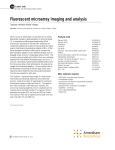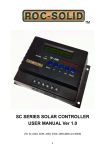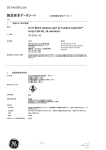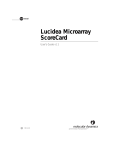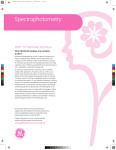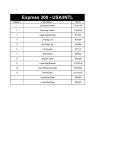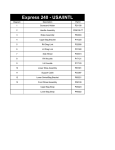Download Lucidea Universal ScoreCard Plate Format
Transcript
application note 728 microarrays Lucidea Universal ScoreCard Plate Format Lucidea Array Spotter Key words: microarray, gene expression, Lucidea, cDNA Other materials required Gene expression profiling with microarrays is being widely used to compare the expression levels of thousands of genes using a single microarray slide. To properly evaluate microarray results, it is necessary to minimize the variations in the measurements so that accurate comparisons can be made within an experiment and across multiple experiments. One method to minimize variations is the use of control samples to quantitatively relate the experimental data to the control data. The control samples also provide a means of validating normalization. Normalization is necessary to factor out differences in dye incorporation, hybridization efficiency, scanner dye sensitivity, and other experimental factors. • Easy-to-Spot™ DNA Human 1.0 (Incyte Genomics) Lucidea™ Universal ScoreCard™ is a set of 23 microarray controls consisting of calibration, ratio, negative, and utility controls. All the controls except the utility controls are artificial genes that generate pre-determined signal intensities and ratios that do not change across samples or experiments. While the utility controls are also artificial genes, their signal intensities and ratios are user definable. Utility controls can be used to troubleshoot and estimate sample recovery during the RNA purification process as well. All the controls are used for validating and normalizing microarray data. They can also be used to generate a calibration curve for determining limits of detection, linear range, and the amount of mRNA in each spot. Using Lucidea Universal ScoreCard with Lucidea Array Spotter ensures high quality and accurate microarray results. This application note describes how Lucidea Universal ScoreCard can be used in association with Lucidea Array Spotter to determine the quality of microarray data. • 50% DMSO Protocol The protocol below represents an example for spotting cDNA on Lucidea Microarray Reflective Slides. The protocol can be modified by the user to accommodate the needs of the experiment. It is recommended to use only 384-well barcoded microplates from Amersham Biosciences for spotting. 1 ● Lucidea Universal ScoreCard target labelling 1.1. Add 2 µl of reference spike mix to the Cy™3 target labelling of human heart mRNA. 1.2. Add 2 µl of test spike mix to the Cy5 target labelling of human spleen mRNA. 1.3. Create an additional 1:5 ratio control using Utility 1 control. Add 1 µl of a 1:5 dilution of Utility 1 spike to the human heart mRNA labelling reaction. Add 1 µl of Utility 1 spike to the human spleen mRNA labelling reaction. 1.4. Proceed with direct labelling and purification of the targets using CyScribe First-Strand cDNA Labelling Kit. 1.5. Quantitate the concentration of the target. 2 ● Lucidea Universal ScoreCard spotting sample preparation Products used Lucidea Array Spotter 63-0040-09 Lucidea Spotting Pens, 24-pen set 63-0040-10 Lucidea Universal ScoreCard, 1000 hybridizations 63-0042-86 Lucidea Microarray Reflective Slides CyScribe™ First-Strand cDNA Labelling Kit 384-well barcoded microplate an 63-0050-26/Rev.A/2003-02 ● p1 inquire 25-8007-67 25-0199-34 Lucidea Universal ScoreCard spotting samples are lyophilized in individual tubes to allow users the flexibility to resuspend the samples in their choice of spotting buffer and customize the format of the spotting plate pattern. microarrays 2.1. Resuspend the samples in 600 µl of 50% DMSO to a final concentration of 20 ng/µl. 50% DMSO is the recommended spotting solution for Lucidea Microarray Reflective Slides. For other spotting buffers and slide types, the required final concentration of Lucidea Universal ScoreCard spotting samples may be different. 5 ● Spotter setup 5.1. Install the Lucidea Spotting Pens pen set. Be careful not to damage the pens. 5.2. Load the plates for spotting. Place the plate containing Lucidea Universal ScoreCard in plate position 1. 3 ● 5.3. Load the slides onto the slide tray. Spotting plate pattern 5.4. Make sure that the plates and slides are seated properly in the correct orientation. 3.1. Transfer 25 µl of each sample to a well in the barcoded 384-well microplate following the format shown in Figure 1. 6 ● 3.2. Centrifuge the plate for 1 min at 2750 × g to spin down the samples. Start spotting 4 ● 6.1. To start the spotting session, click Start in the Lucidea Array Spotter Control window. Spotting parameters 4.1. Create or edit a spotting protocol to the spotting parameters in Table 1. P O 6.2. If more than 12 plates are being spotted, the Change Plates In timer will include when to change the plates, drain the waste container, and fill the wash solutions and humidifier if necessary. N M L K J I H G F E D C B A 1 2 3 Fig 1. Spotting Plate Pattern setup for the Lucidea Universal ScoreCard control plate on the Lucidea Array Spotter. The arrangement of the calibration (Calib), ratio, negative (Neg), and utility controls are shown. 4 5 6 Calib 01 Calib 02 Calib 03 7 Calib 04 8 Calib 05 9 Calib 06 10 11 Calib 07 12 Calib 08 13 Calib 09 14 Ratio 3 15 Ratio 4 16 17 Ratio 7 18 Ratio 8 19 Utility 1 20 Neg 1 21 22 23 24 an 63-0050-26 ● p2 Neg 2 microarrays Table 1. Spotting parameters for Lucidea Array Spotter. The spotting parameters are user-definable. For more information please refer to the Lucidea Array Spotter User’s Guide (1). Parameters Total slides: Total plates: Spotting mode: Replicates: Repeats: Complete last row: Use default pitch: Row pitch: Column pitch: Slide thickness: Barcode enable: Output file enable: Humidity control: Humidity setting: Rows per block: Columns per block: Spots in last row: cDNA 27 8 Normal 2 1 Yes No 250 µm 250 µm 0.9–1.1 mm ✔ ✔ ✔ 65% RH 8 16 16 7 ● Spotting complete 7.1. At the end of the spotting run, a message window will appear stating “The spotting session is complete. Please remove your sample plates and slides. If you click OK, the humidifier will be turned off.” Leave the humidifier on by not pressing OK. 7.2. Allow the slides to remain inside Lucidea Array Spotter for 30–60 min depending on the drying rate of the spotting solution used. This step allows all the spots on the slides to dry under the same humidity conditions. good morphology and good reproducibility as seen when visually comparing the spot intensities of duplicate spots. The nine calibration controls span a range from 3 to 30 000 pg/2 µl of spike. The four ratio controls have a targeted Cy3/Cy5 ratio of 3:1 and 10:1 and the reverse ratio for both. The utility control has a targeted Cy3/Cy5 ratio of 1:5. Fig 2. A section of the microarray image. Cy3-labelled cDNA heart (shown in green) and Cy5-labelled cDNA spleen (shown in red) target were mixed and hybridized onto a spotted slide with a total of 2688 human genes printed in duplicate. Shown here are two duplicate blocks out of a total of 48 blocks of spots on the whole slide. Row 1 of each block contains the calibration (yellow boxed), negative (red boxed), ratio (green boxed), and utility (blue boxed) controls from Lucidea Universal ScoreCard. Rows 2 through 7 contain a duplicate set of 112 human genes from Easy-to-Spot DNA Human 1.0. The calibration controls can determine the dynamic range of the slide. The concentrations of the calibration controls used in this experiment span over four orders of magnitude. The average signal intensities from the calibration control spots of the experiment show that this slide has a dynamic range of approximately 3–3.5 orders of magnitude, as seen in Figure 3. For higher expressing genes, the DNA on the spot was hybridized to saturation causing the fluorescence intensity to plateau. For lower expressing genes, the signal of the spots was not high enough above background to be quantitated accurately. Calibration Curve 7.3. Then press OK and unload the plates and slides and remove the pen set as instructed by the Lucidea Array Spotter User’s Guide. The slides were fixed and hybridized following the slide manufacturer’s protocol. The slides were manually hybridized with 17 pmol of Cy3-labelled human heart and 17 pmol of Cy5labelled human spleen cDNA targets. Slides were imaged using an GenePix™ 4000B Array Scanner. The slide images were quantitated using ArrayVision™ 6.0 software. Results From Figure 2, the spotting quality of Lucidea Universal ScoreCard controls and Easy-to-Spot DNA Human 1.0 genes using Lucidea Array Spotter is shown. The spots all have an 63-0050-26 ● p3 Average Signal Intensity (rfu) 10 000 000 Cy5 1 000 000 Cy3 100 000 10 000 1000 1 10 100 1000 10 000 100 000 Amount of RNA (pg) Fig 3. Calibration curve from Lucidea Universal ScoreCard calibration controls for the microarray slide. The average signal was calculated for each calibration control. The signal intensities for Cy3 and Cy5 have been background subtracted. Rfu is an abbreviation for relative fluorescent unit and is a measure of fluorescence intensity. microarrays The accuracy of the normalization protocol can be determined from Lucidea Universal ScoreCard controls. This can be done by comparing the normalized Cy3/Cy5 ratios against the expected Cy3/Cy5 ratio of the controls. For each CyDye™ label, constant factor normalization was performed on the quantitated data using the average signal from the spots as the constant factor. The constant factor is divided into the signal of each spot to normalize the data. From Table 2, it can be noted that, in general, the normalization procedure brings the Cy3/Cy5 ratio much closer to the expected Cy3/Cy5 ratio than when using the raw signal intensities. Calib 8 and Calib 9 have a low mRNA spike concentration of 10 and 3 pg/2 µl of spike, respectively. As a result, Calib 8 and Calib 9 have spot signals close to background which causes high signal variation and skewing of the normalization ratios. Table 2. Lucidea Universal ScoreCard ratio analysis (Cy3/Cy5). Calib stands for calibration. Expected ratios are determined from the known mRNA spike concentrations. Raw ratios are calculated from the observed Cy3 and Cy5 signal intensities. Normalized ratios are calculated from the constant factor normalized Cy3 and Cy5 signal intensities. The ratios listed in the table are the average of the Cy3/Cy5 ratios for each control. Ratio Analysis (Cy3/Cy5) Control (Cy3/Cy5) Expected Raw Normalized Calib 1 1.00 0.49 0.91 Calib 2 1.00 0.54 1.00 Calib 3 1.00 0.63 1.16 Calib 4 1.00 0.60 1.12 Calib 5 1.00 0.50 0.93 Calib 6 1.00 0.68 1.27 Conclusions Calib 7 1.00 0.63 1.16 Calib 8 1.00 1.06 1.96 Lucidea Universal ScoreCard is an essential tool for microarray analysis. Lucidea Universal ScoreCard controls make it possible to validate normalization and generate calibration curves for microarray data. Most importantly, having Lucidea Universal ScoreCard controls on microarray slides allows the comparison of data from multiple experiments. Together with Lucidea Array Spotter, microarray data is generated with excellent accuracy and quality. Calib 9 1.00 0.88 1.63 Ratio 3 3.00 1.67 3.11 Ratio 4 0.33 0.16 0.30 Ratio 7 10.00 4.90 9.10 Ratio 8 0.10 0.06 0.12 Utility 1 0.20 0.08 0.15 References 1. Lucidea Array Spotter User’s Manual, Amersham Biosciences, pp. 375–752 (2002). Asia Pacific Tel: +852 2811 8693 Fax: +852 2811 5251 Australasia Tel: +61 2 9899 0999 Fax: +61 2 9899 7511 Austria Tel: 01 576 0616 22 Fax: 01 576 0616 27 Belgium Tel: 0800 73 888 Fax: 03 272 1637 Canada Tel: +1 800 463 5800 Fax: +1 800 567 1008 Central, East, and Southeast Europe Tel: +43 1 982 3826 Fax: +43 1 985 8327 Denmark Tel: 45 16 2400 Fax: 45 16 2424 Finland & Baltics Tel: +358 (0)9 512 39 40 Fax: +358 (0)9 512 17 10 France Tel: 01 69 35 67 00 Fax: 01 69 41 96 77 Germany Tel: 0761 4903 291 Fax: 0761 4903 405 Italy Tel: 02 27322 1 Fax: 02 27302 212 Japan Tel: +81 3 5331 9336 Fax: +81 3 5331 9370 Latin America Tel: +55 11 3933 7300 Fax: +55 11 3933 7315 Middle East and Africa Tel: +30 210 96 00 687 Fax: +30 210 96 00 693 Netherlands Tel: 0165 580 410 Fax: 0165 580 401 Norway Tel: 2318 5800 Fax: 2318 6800 Portugal Tel: 21 417 70 35 Fax: 21 417 31 84 Russia & other C.I.S. & N.I.S. Tel: +7095 232 0250, 956 1137 Fax: +7095 230 6377 Southeast Asia Tel: +60 3 8024 2080 Fax: +60 3 8024 2090 Spain Tel: 93 594 49 50 Fax: 93 594 49 55 Sweden Tel: 018 612 1900 Fax: 018 612 1910 Switzerland Tel: 01 802 81 50 Fax: 01 802 81 51 UK Tel: 0800 616928 Fax: 0800 616927 USA Tel: +1 800 526 3593 Fax: +1 877 295 8102 Amersham Biosciences UK Limited Amersham Place, Little Chalfont, Buckinghamshire, England HP7 9NA Amersham Biosciences AB SE-751 84 Uppsala, Sweden Cy, CyDye, CyScribe, Lucidea, and ScoreCard are trademarks of the Amersham Biosciences Ltd Amersham and Amersham Biosciences are trademarks of Amersham plc ArrayVision is a trademark of Imaging Research Inc Easy-to-Spot is a trademark of Incyte Genomics GenePix is a trademark of Axon Instruments Inc Amersham Biosciences Corp. 800 Centennial Avenue, PO Box 1327, Piscataway, NJ 08855 USA Amersham Biosciences GmbH Munzinger Strasse 9, D-79111 Freiburg, Germany Amersham Biosciences (SV) Corp. 928 East Arques Avenue, Sunnyvale CA 94085 USA an 63-0050-26 ● p4 © Amersham Biosciences Corp. 2003—All rights reserved All goods and services are sold subject to the terms and conditions of sale of the company within the Amersham Biosciences group which supplies them. A copy of these terms and conditions is available on request. www.amershambiosciences.com




